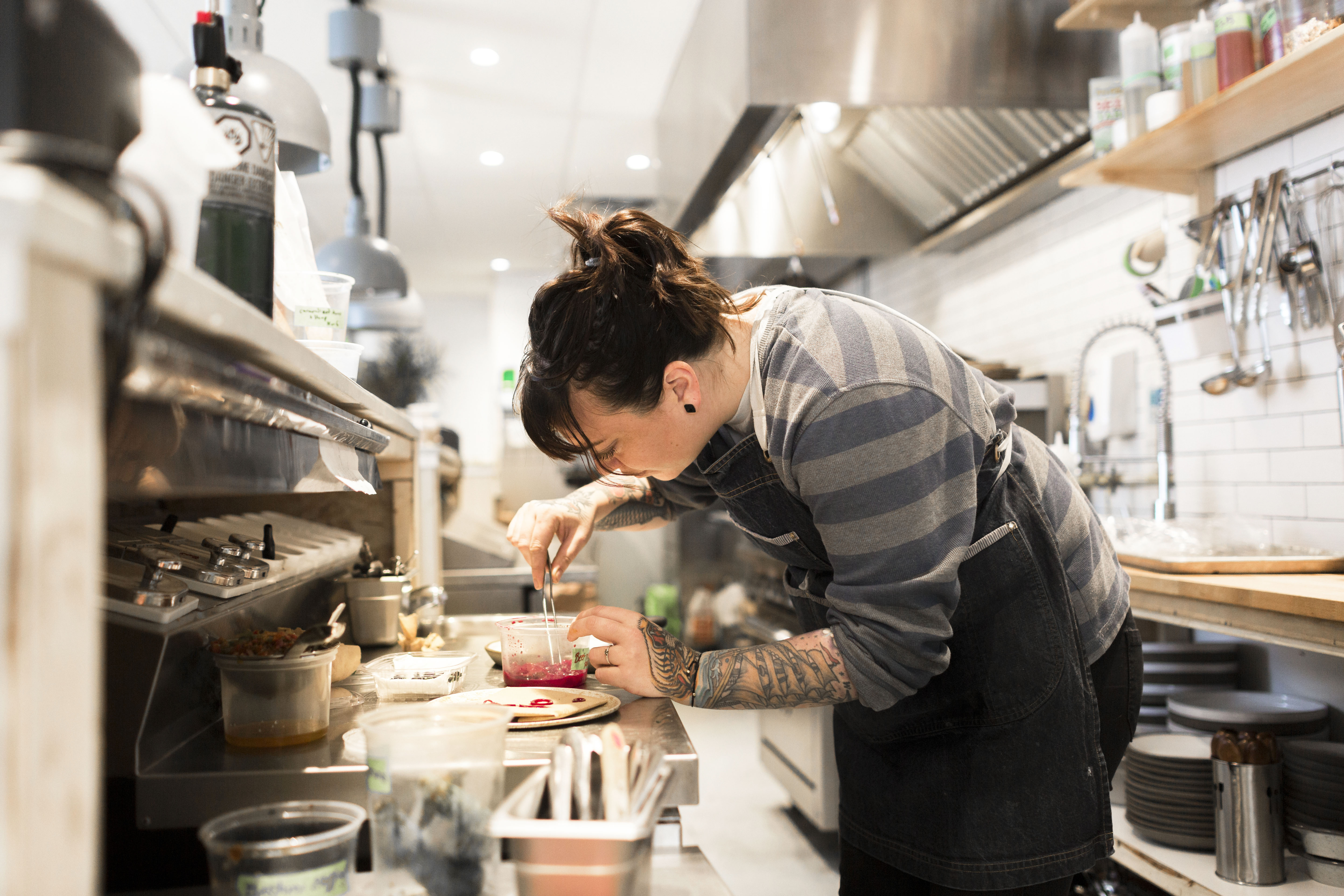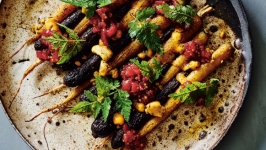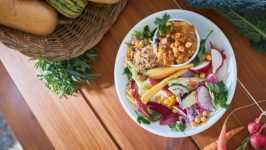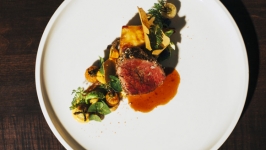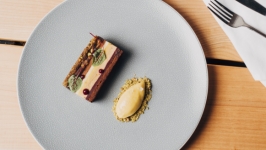Boldly, Proudly, Exclusively, Canadian
Seabucktorn ketchup, Canadian “olives,” fresh yuzu grown in the Eastern Townships and local honeycombs the bees whipped up in the autumn. With trademark enthusiasm, chef Dominique Dufour, chief alchemist and giver-of-experiences at Gray Jay, is offering tastes of each of these things. In the back of the kitchen, which runs along almost the entire restaurant space, her fiancé and co-owner, Devon Bionda shows off some reindeer moss and some dehydrated parsnip skins.
In case there was any doubt, this restaurant’s menu is boldly, proudly and exclusively Canadian. There’s no coffee on offer — Canadian farmers don’t grow coffee beans, at least not yet — and the chefs don’t have access to lemons either. All of the spirits on offer are Canadian as is the craft-only beer. The wine hails from different corners of the world, however.
So how do you come up with a salad for a winter menu when faced with those challenging parameters? The dish Dufour chose to show us when we asked for something that represented her on a plate highlights how she overcomes the challenge she’s created for herself. The dish starts with a slightly roasted hollowed- out zucchini that’s filled with a fine dice of green pepper, pearl onions, roasted zucchini and roasted red peppers.
“It’s all the flavours of a Greek salad in this one little beautiful vessel,” Dufour says.
Enveloping the tube-shaped presentation is a gel made of ewe’s yogurt and house-made sunflower-seed tahini that’s made to taste like feta.
She lets the gel set and then cuts the right-sized piece and blowtorches it so it slowly takes the shape of the zucchini. Then it goes back in the fridge to set. Garnishes include fermented pea powder and beet-marinated pearl onions, dill and black daisies.
“I can buy [Canadian] feta — I just wanted to create something different,” Dufour says. “It has the feta taste, but you can also taste the nuttiness from the sunflower seeds — and the acidity.”
Getting that acidity is a hard-fought battle for Dufour, but fortunately and somewhat surprisingly, there’s a yuzu grower in Quebec.
“He’s been breeding them for 20 years, but only recently did they start producing fruit,” Dufour says. “Every year in October, we get our harvest and we preserve them for the whole year. We do the zest, the juices, the pulp gets dehydrated and made into a powder and we do extracts even with the seeds.”
How does she know how many she’ll need? It hardly matters. They buy as many as he’ll sell them and then they have to make do. This year’s harvest is literally a shoe box and it’s not full. She shows them off as proudly as one might a newborn child.
“This year, we just made it,” she says. “We got the new delivery [just after we’d run out.]”
Canada-only means foraging
Dufour, who is one of 12 contestants competiting on Top Chef Canada, which airs between April and June 2020, says the Canada-only theme at her restaurant is “a hard pill to swallow sometimes” because they have to say no to people a lot.
“When people want lemon in their water, we have to say no,” she says. “We can’t serve coffee after dinner. We only have Canadian spirits.”
But on the plus side, Canadians can proudly tell themselves they’re eating only native foods.
Instead of lemon, she often uses vinegar and verjus, an unfermented wine favoured by chefs. She buys hers from Featherstone Estate Winery and Vineyard.
Often, she fills in the gaps by foraging on her morning walks through the woods with Bionda and their dog. Leisure time for this plucky couple is also spent in nature, gaining a better understanding of where their food comes from.
Instead of coffee, restaurant-goers will be treated to a blend of tea made from a collection of things they foraged, including lilacs and berries.
They get reindeer moss in Calabogie and sumac in Gatineau. In the spring, they forage small wild peas, pea flowers, pinecones, pineapple weed leaves and blooms, day lily stems and buds. Spruce tips are another foragable staple.
“Give them a taste of the pinecone vinegar,” Dufour tells her fiancé. The vinegar is made from baby pinecones and is unctuous and other-worldly. The Canadian olives made with green wild plums Bionda offers next are a very near impersonation of the Greek essential.
“They definitely have the flavour,” Dufour says. “They just need a little longer to develop the texture.”
The pinecone vinegar went on elk on the game menu, which ran from January to March. They do game at that time because it’s the only thing available during the winter.
“We want to respect the seasons,” Dufour says. For the elk dish, she’ll braise the meat on a skewer of pine branch and serve it with boiled new potatoes with smoked elk fat, fermented butter, fresh herbs, steamed baby kale greens and fermented cranberries.
“Then there’s a bone jus to pour over the elk,” she says. “The potatoes are finished in a pinecone vinegar.”
Pineapple weed is a small herb in the chamomile family, but it’s much sweeter than chamomile. She makes an extract out of it and mixes it with white rye from Ontario. It produces a sweet elixir that does taste like pineapple with a vague chamomile finish.
“I use it like vanilla extract in cakes,” Dufour says. “In an upcoming dessert, I’ll be putting it in a semifreddo.”
As for the seabuckthorn ketchup, which is a savoury orange condiment, it’s going on a chicken leg and chicken-foot dish.
“The chicken feet are really just there to act as a skewer,” Dufour says.
In another forage, they harvested “a tonne” of St. Croix and Pinot grapes. Topped up with a few from another forager, they had buckets of grapes that they’re now fermenting in an old wine barrel.
“We’ll store them in there — and we’ll make our own balsamic with them,” she says.
Balsamic is something Bionda misses; Dufour likes its viscosity.
“There’s something absolutely amazing about the simplicity of it,” she says. “It’s an easy go-to. It dresses things up so simply.”
Another post-dinner treat is a Canadian cheese dish with honeycombs from Les Mielles d’Anisette. They serve the honey, which comes on large washboard-shaped rectangular screens, tableside. This crop is from the fall harvest, when the bees no longer polenate the flowers, so it has notes of squash blossom and linden flowers, which give it juicy pear and wild mint flavours.
Spooning some straight onto spoons for tasting, Dufour explains that they serve it with cheese and puff pastry with salted maple on top.
The culinary roots run deeply
Dufour grew up in Montreal and originally went to fashion school, studying business and fashion production. She moved to Vancouver to pursue that dream, but continued to work in restaurants to support herself. It was then, when she was in her very early 20s, that an ex-boyfriend pointed out that the only time she seemed to have fun was when she was in the restaurant.
“You come home and you try things you’ve learned," he told her. “This needs to be your career. Go with what you love.”
Eventually, she was convinced and after the 2010 Olympics, she moved from Vancouver to Toronto to go to George Brown culinary school and then spent six years in Toronto, where she worked for four years for ICON Legacy.
She worked first for the Spanish restaurant, Patria, and then was part of the opening team at Byblos, which serves contemporary Mediterranean.
“I met Devon at Byblos,” she says. “We started dreaming. We moved to Yukon together to cook, because we wanted to be closer to nature. Living in Toronto messes with your head. You never see a farm or a producer. Everything comes by truck. We just wanted to reconnect.”
There, they realized how much work goes into producing vegetables in Yukon and learned how one can harvest kale into November in Yukon.
“It’s crazy,” Dufour says. “You have to blanket veg when you have 24-hour sunlight.” The 24 hours of darkness presented similar challenges.
“Toronto is so multicultural, it pulls you in a lot of different directions,” she says. “It blurs the line of what’s yours and what isn’t. You’re constantly bombarded with so many cultures, it’s easy to lose yourself. In Yukon, we both found the sense of how we connected with food — what our food culture and story was like.”
After the Yukon stint, they moved to Montreal for a couple of years. They worked at Ledger Restaurant & Bar, Magdalena and Le Pier 66 and Dufour created the association of women chefs of Montreal. For that, she produced a series of conferences called Women with Knives and that’s where she met Madame Germain, of Le Germain hotels.
“She was building the restaurant for her hotel [in Ottawa] and the person who was supposed to open the restaurant fell through,” Dufour explains. “She asked if I could write them a menu and then it [changed] to a two-month thing and then she asked me to move here for a year.”
While Le Germain holds a lot of the same values as Dufour — it’s a family business, it wanted Canadian food, it encourages entrepreneurs and it’s eco-concious — it turned out the hotel business wasn’t for her. So by the time her one-year contract was up, she and Blondia had already found the location for Gray Jay and they spent the next five months preparing to open. They opened on a very Canadian day — July 1, 2019.
Today, the Jay is soaring high, with increasing numbers month over month. Dufour’s passion is also still burning bright.
“There’s a real luxury to being able to consume these items because they’re so fleeting,” she says, referring to all the exclusively Canadian specialties she highlights week after week.
Rene Redseppi — the chef of Noma — made a comment that resonates with her. He said nowadays, you can buy caviar in airports. All the old luxuries are accessible — all you need is money. The thing that money can’t buy is experiences.
“And that is absolutely priceless,” she says. Offering an experience is her solemn promise to anyone who graces her door.
Gray Jay
400 Preston St., Ottawa, Ont.
grayjayhospitality.com | 613.680.0380 | @grayjay613
Dufour's time on Top Chef Canada
Season eight of Top Chef Canada is set to air on Food Network Canada this
spring and Ottawa is well represented by two of 12 chefs in the competition: Dominique Dufour of Gray Jay and Imrun Texeria, sous-chef at Stofa Restaurant in Wellington West. edible Ottawa chatted with Dufour about her experience.
edible Ottawa: Why did you decide to try out for Top Chef Canada?
Dominique Dufour: It was a hard decision for me to participate in Top Chef. They scouted me out and my first answer was no. I had just opened a restaurant and I didn’t think I had time. But with a little research, and with realizing that I could get a great deal of exposure to help promote my new venture, I decided that it was worth participating.
EO: What was the most challenging part?
DD: The lack of sleep. The filming schedule is very hard. Physically, it is very demanding.
EO: What are you most proud of from your time on the show?
DD: I am proud of the fact that, no matter what, I remained true to myself. It was important to me to not be catty,
to stay respectful of other contestants. After it is all said and done, we all need to live with ourselves and I wanted a clear conscience. I wanted to do beautiful soulful food. Sometimes it landed, sometimes it didn’t, but life is a learning experience and I did learn a lot from it.


